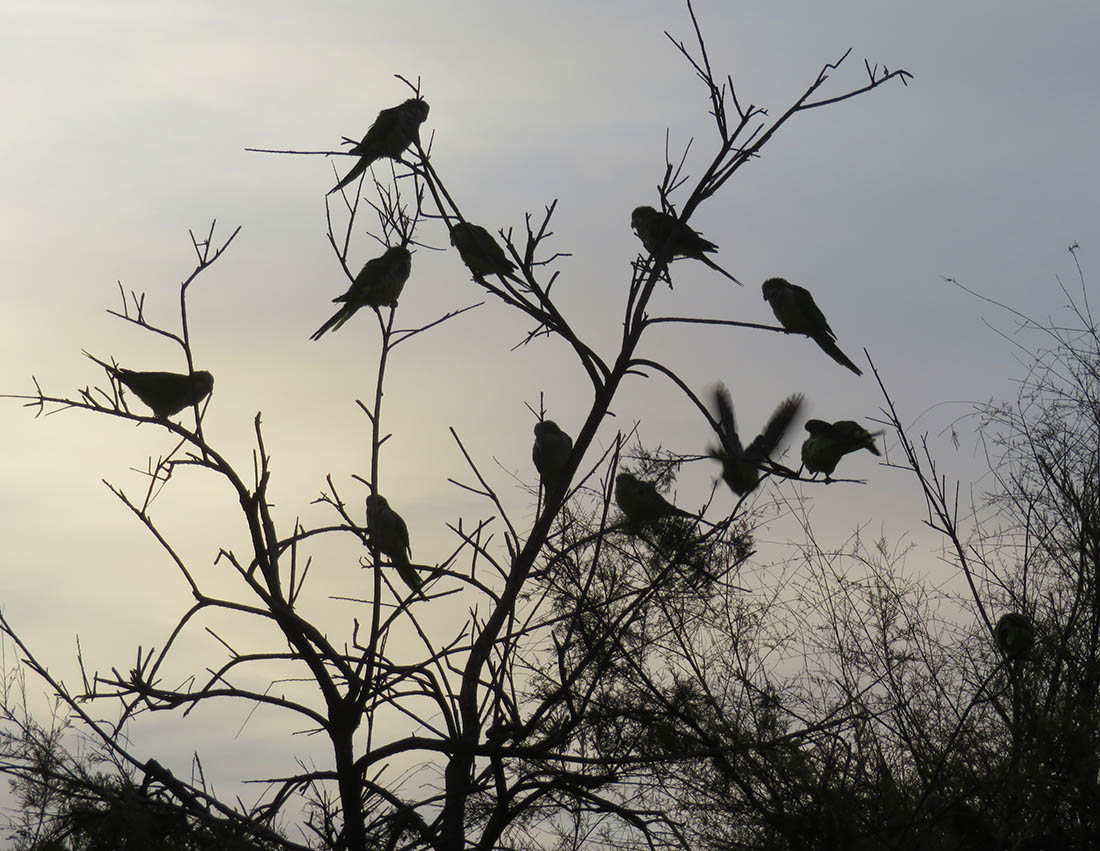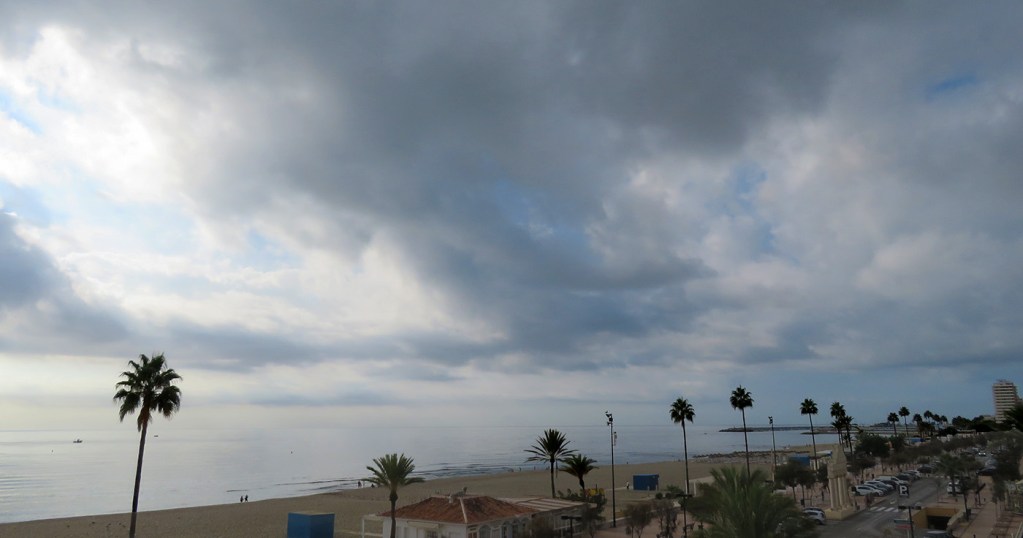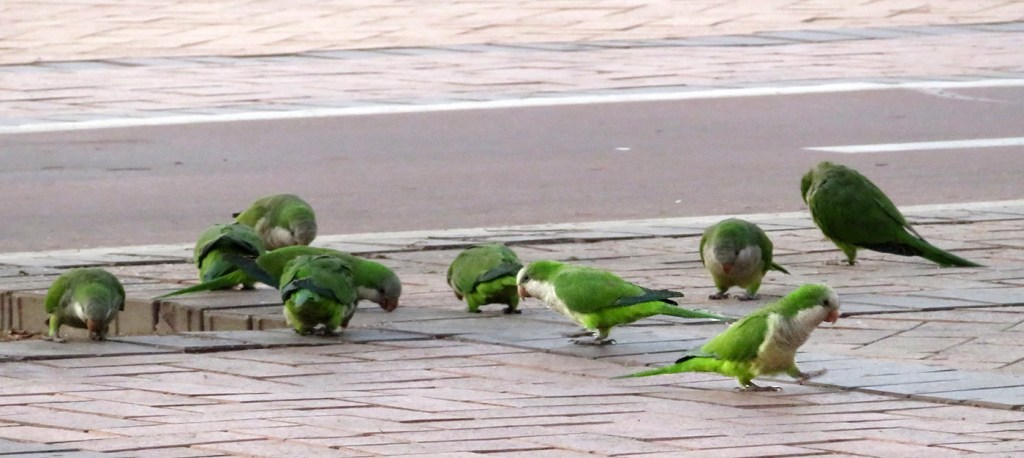La versión en español está después de la versión en inglés.
ONE OF OUR NEARBY ROUNDABOUTS (traffic circles if you’re from New Jersey, rotaries in Massachusetts, glorietas or rotondas if you’re in Spain)… Where was I? Oh, yes, a simple roundabout in the nearby neighborhood of Torreblanca — a 15-minute walk from home — warms my heart. It’s called The Rainbow Roundabout (Glorieta Arco Iris) and is dedicated to a “respect for equality and diversity for humanity, regardless of gender identity or sexual orientation.”
During one of the phases of Lockdown, when I was permitted to walk one kilometre in any direction from home, if I headed in the direction of the Rainbow Roundabout I could go as far as the chiringuito (beach bar) just before the turn-off. The chiringuito is called Martin Playa (Martin Beach) and has a large mosaic on one wall with a portrait of a fisherman who I assume is Martin. It’s not very flattering (or maybe it is) but it’s got its own charm.
Someone has lately been tossing bread on the Paseo right across the street from us to feed the local monk parakeets (also known as Quaker parrots). Yes, they’re adorable, but they’re an introduced species from South America and have become a nuisance in many cities around Spain. They destroy local foliage (they’re one of the reasons many of our tamarind trees don’t survive), take over nests of other birds and chase local bird populations away, and — thanks to the bread — crap all over large sections of pavement, which is not only an eyesore but a danger to pedestrians who slip in the mess. The sanitation department is out there daily cleaning things up. I haven’t seen the bread for a few days. Here’s hoping the person with good intentions was told to stop. Actually, it just dawned on me, the chiringuito across the street from us closed for the season just a few days ago. Some well-meaning staffer must have been tossing the restaurant’s scraps.
There are clouds in the sky and there’s a 2 percent chance of rain. Dare I hope?
.
UNA DE NUESTRAS ROTONDAS CERCANAS (traffic circles si eres de Nueva Jersey, rotaries en Massachusetts) … ¿Dónde estaba? Oh, sí, una simple rotonda en el cercano barrio de Torreblanca, a 15 minutos a pie de casa, me alegra el corazón. Se llama Glorieta Arco Iris y está dedicada al “respeto a la igualdad y la diversidad para la humanidad con independencia de su identidad de género u orientación sexual”.
Durante una de las fases de Lockdown, cuando se me permitió caminar un kilómetro en cualquier dirección desde casa, si me dirigía en dirección a Glorieta Arco Iris podía llegar hasta el chiringuito justo antes del desvío. El chiringuito se llama Martín Playa y tiene un gran mosaico en una pared con el retrato de un pescador que supongo que es Martín. No es muy halagador (o tal vez lo sea) pero tiene su propio encanto.
Alguien ha estado tirando pan últimamente en el Paseo justo enfrente de nosotros para alimentar a los periquitos monje locales. Sí, son adorables, pero son una especie introducida de Sudamérica y se han convertido en una molestia en muchas ciudades de España. Destruyen el follaje local (es una de las razones por las que muchos de nuestros tamarindos no sobreviven), se apoderan de los nidos de otras aves y ahuyentan a las poblaciones de aves locales y, gracias al pan, se cagan en grandes secciones de pavimento, que no solo es una monstruosidad, sino también un peligro para los peatones que se deslizan en el desorden. El departamento de saneamiento está limpiando cosas a diario. Hace unos días que no veo el pan. Esperamos que se le haya dicho a la persona con buenas intenciones que se detenga. En realidad, me acabo de dar cuenta, el chiringuito al otro lado de la calle cerró por la temporada hace solo unos días. Algún miembro del personal bien intencionado debe haber estado tirando las sobras del restaurante.
Hay nubes en el cielo y hay un 2 por ciento de probabilidad de lluvia. ¿Me atrevo a esperar?






Un tamarindo desnudo. El lugar perfecto para descansar, especialmente después de eliminar todo el dulce crecimiento joven.






.
.




(sings) I’ll be the roundabout
The words will make you out ‘n’ out
LOVELY traffic circle. and pretty birds, but what a mess! the mural reminds me of a pirate; needs an eyepatch.
anne marie:
The birds are very entertaining but have become a serious problem. Málaga City has been working on eradicating them. That hasn’t hit here yet.
Our ’roundabouts’ were once called ‘rotaries’ till new rules were deemed necessary to make things safer for all.
But the Monk Parakeets are so beautiful and exotic……I can hear all the tourists saying. It is a shame when this kind of thing happens everywhere and anywhere.
Great photos.
Jim:
When I moved to Boston I asked what the rules were in rotaries (we didn’t have them in New York). I was told to simply not make contact with other drivers; then whoever made it through first was the winner. Driving in Boston!
You just know the queer in me loves a rainbow.
But then poor Martin; he’s had a rough day at sea.
And that black-and-white pic took me to The Birds on the jungle-gym outside the school.
Bob:
Yeah, I think Martin looks rough, too. But, portraits usually flatter. That black and white pic is actually color like the rest. Taken in the direction of the sun over the sea. The Birds gave me nightmares for years. My worst horror film experience.
I’m with Bob on The Birds thing. The color picture following is the gay version. I’ve always found it weird and unnatural for parrots of any kind to be in flocks. They should be found one or two at a time, in cages or zoos 🙂 Martin Playa when pronounced in English would be a good name for a pimp.
Deedles:
Martin Playah! I love it. You’re so clever. We drove about 10 minutes outside town once to a small garden center. Across the road was a cluster of untrimmed palm trees. They were filled with hanging nests and hundreds upon hundreds of monk parakeets.
Green pigeons. I think Martin has a nice smile. Rainbows make me happy.
Wilma:
Rainbows make me happy, too. Wish I could see a real one soon. And, yeah, the monk parakeets – although cute – are even worse than our local pigeons when it comes to the damage they do to flora and fauna (and pavement).
The Rainbow Roundabout sounds like a great idea. Every city should have one.
Kirk:
It’s nice to see in our small city. I didn’t remember it being here when we arrived in 2013. Turns out it wasn’t.
Hey, love that Rainbow Roundabout! And Martin has one helluva bad combover.
Debra:
So glad you noticed the combover! I was going to mention it and didn’t. Hilarious that it was included in the portrait.
Rainbows and diversity everywhere. The birds are pretty, if in the wrong place. Coastal Florida is starting to see flocks of non-native birds, released or escaped.
David:
The non-native species can present so many problems. These flocks started out with a few pets that either escaped or were released.
No denying those Quaker parrots are pretty.!!! I was once told technically one is not to feed bread to birds….once water is drank they can bloat and die. Maybe that’s what someone had in mind? Here is new hope by the river there are signs blantly saying no bread. Only grain pellets and other seeds and grains, cornmeal pellets.
And that traffic circle is very cheery!!!!
Mistress Maddie:
SG had said, “Bread isn’t even good for them.” I wonder if there was an ulterior motive. Whatever, it doesn’t appear to have worked.
My Someone hasn’t toasted bread in decades; he does not like the stuff.
Urspo:
So if you toss some at him, he just leaves it uneaten. What a waste.
Roundabouts are the new rage here. More and more intersections are being converted to them, and it is a good thing and it makes sense. I loved looking at the rainbow roundabout. I remember when I was in Barcelona years ago seeing tons of parrots in the trees.
mcpersonalspace54:
They’re very common here, but don’t work too well at the ends of highway exit ramps with the increasing traffic. These parrots have become a serious problem in the bigger cities, which have begun to combat the problem. Here in Fuengirola that hasn’t happened yet. But i feel like there are a lot more in town since the pandemic. They began to show up everywhere and in large numbers during lockdown.
You live in such a beautiful place. The parakeets seem cute, but I can understand that they’re a nuisance. We had a problem with feral cats in our neighborhood because some people fed them. The cats totally ignored the rats because they were so well fed. The feeding had to stop and most of it has. Voila: not so many cats wandering around.
Love,
Janie
janiejunebug:
Some cities have actually been shooting the monk parakeets to keep numbers down. They say it’s more humane than trapping them and euthanising (less stressful for the birds). People feeding them or any other invasive visitors only makes things worse.
The green Parakeets are so cute walking around but they can make a mess.
parsnip
Parsnip:
The mess is unpleasant but the damage they do to native wildlife and plants is even worse.
Love the rainbow roundabout! And those parrots are beautiful, and different from the invasive ones we have here — ours are ring-necked parakeets, I think. But there are monk parrots in Florida, and they’re introduced there as well. I guess it’s impressive that they’re so adaptable.
I’m struck by how bright and sunny your pictures are. We’re definitely getting into winter mode here. Our light levels are already quite diminished.
Steve:
The parrots ARE beautiful and they’re supposedly really good talkers. It’s not called the Costa del Sol for nothing. Even in winter!